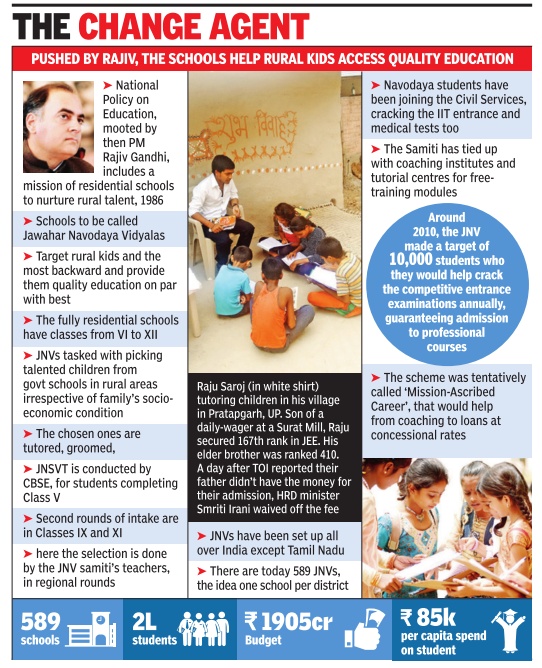Jawahar Navodaya Vidyalayas

This is a collection of articles archived for the excellence of their content. |
Government spends
The Times of India, Jun 21 2015
Rema Nagarajan
Govt spends 85K on each Vidyalaya student annually
The excellent results of Navodaya Schools and the remarkable performance of their students in competitive examinations are proof of the government's ability to run good schools and provide quality education when it puts its mind, and more importantly , its money into it. Consider the budget allocated for the Navodaya Vidyalaya Samiti in 2015-16, Rs 1905 crores to run 589 schools with over 2 lakh students.The per capita spending on a student annually works out to be roughly Rs 85,000. Similarly the Kendriya Vidyalaya Sanghatan which runs 1,099 schools with over 11.7 lakh children studying in them got a budget allocation of Rs 3,190 crore. That works out to roughly Rs 27,150 spending per student.
Students studying in Navodaya and KV put together are less than 1% of total number of students studying in regular government schools, over 14.7 crore. Now consider the entire budget allocation for 12.2 crore students studying in government-run elementary schools (Class I-VIII) in 2013 -just Rs 37,150 crore. This works out to just over Rs 3,000 per student for the whole year. A similar calculation for students studying in government-run secondary and higher secondary schools (Class IX-XII) shows that the allocation amounts to less than Rs 4,000 per student annually .
However, the Centre bears only one fourth of the total government spending on education whereas the rest of the amount comes from the state governments. Hence, the total public expenditure on each student in a govern ment school could range from Rs 12,000 per student at the elementary level to Rs 16,000 at the secondary and higher secondary level.
If we compare the annual allocation for regular government school students with that for Novodaya or KV students, the allocation for each Navodaya student is five to seven times and for a KV student it is almost double. Of course, in the case of Navodaya schools, the expenditure is higher also because they are residential schools unlike KV schools.
India's total public expenditure as a percentage of the GDP is about 3.5%, well short of the 6% recommended by the Kothari Education Commission in 1966 and reiterated by the Central Advisory Board of Education (CABE) committee in 2006. In most developed countries including the UK, Norway and Netherlands public spending on education amounts to about 6% of their GDP .
“Navodaya or Kendriya Vidyalaya schools are just for a select few. We should be demanding similar kind of investment in other government schools too rather than feel smug about what Navodaya schools are able to achieve. Navodaya schools show what opportunities can do for children, even from deprived background.If they are given conducive circumstances, their lives could change. If a few hundred government-run schools are doing so well, why aren't all government schools doing so? That is because there is differential resource allocation,“ explained Poonam Batra of the Central Institute of Education, Delhi University .
Instead of advocating for greater resource allocation, there is a strong lobby saying that government schools are dysfunctional and seeking privatisation of school education.